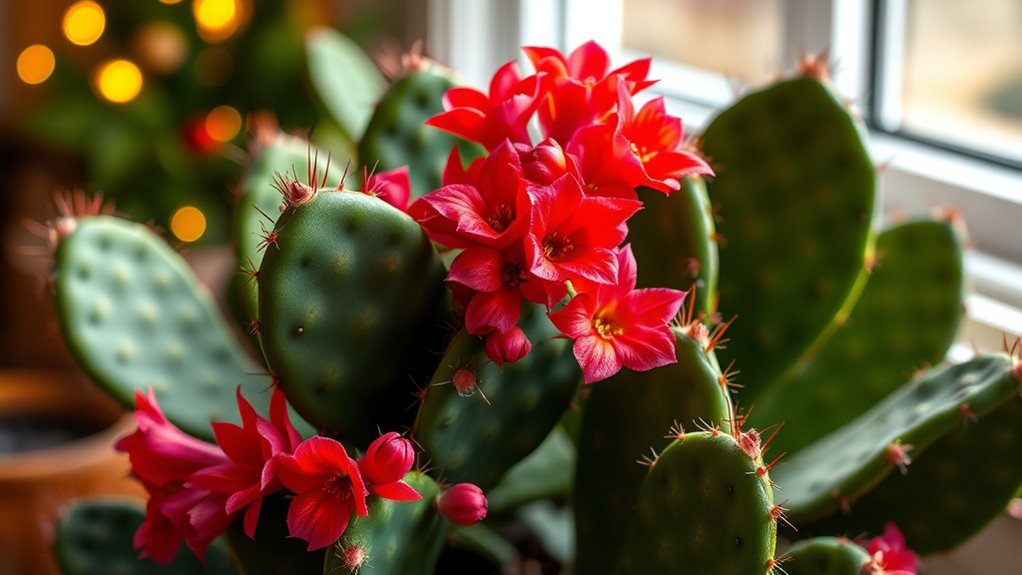To get your Christmas cactus to bloom, you need to mimic natural winter conditions. Provide 12-14 hours of darkness for 6-8 weeks, preferably using blackout curtains or dark rooms, and keep temperatures around 60-68°F. Reduce watering and switch to phosphorus-rich fertilizer during bud formation. Prune after flowering to encourage new growth. Consistently managing light, temperature, and care routines will help you achieve vibrant blooms—continue below to learn more tips.
Key Takeaways
- Provide 12-14 hours of uninterrupted darkness for 6-8 weeks starting in late September to trigger flowering.
- Maintain cool temperatures between 60°F and 68°F and reduce watering to promote bud formation.
- Use a bloom-boosting fertilizer high in phosphorus once buds appear, and cease nitrogen fertilization beforehand.
- Prune after flowering to encourage new growth and remove leggy stems, supporting future blooms.
- Ensure bright, indirect light during the day and prevent light leaks during the dark cycle for successful blooming.
Understanding the Flowering Cycle of Christmas Cactus

Understanding when and how your Christmas cactus blooms is key to ensuring vibrant flowers during the holiday season. Blooming begins when the plant experiences a specific light cycle, mainly a dark period of about 12 hours each night for six weeks. This dark period signals bud formation, which is vital for flowering. Proper timing, usually in late September or early October, allows buds to develop and open around the holidays, lasting several weeks. During this process, maintaining a consistent dark period each night is essential. Once buds are formed, the plant becomes more tolerant of light and temperature variations, but the dark period remains essential for successful flowering. Additionally, understanding the plant’s flowering cycle can help you optimize conditions for peak blooms. Maintaining appropriate light conditions and consistent care during this critical period increases the likelihood of a spectacular display. Moreover, controlling temperature and providing adequate humidity can further support the plant’s blooming process for the best results.
Optimizing Light Conditions for Bud Formation
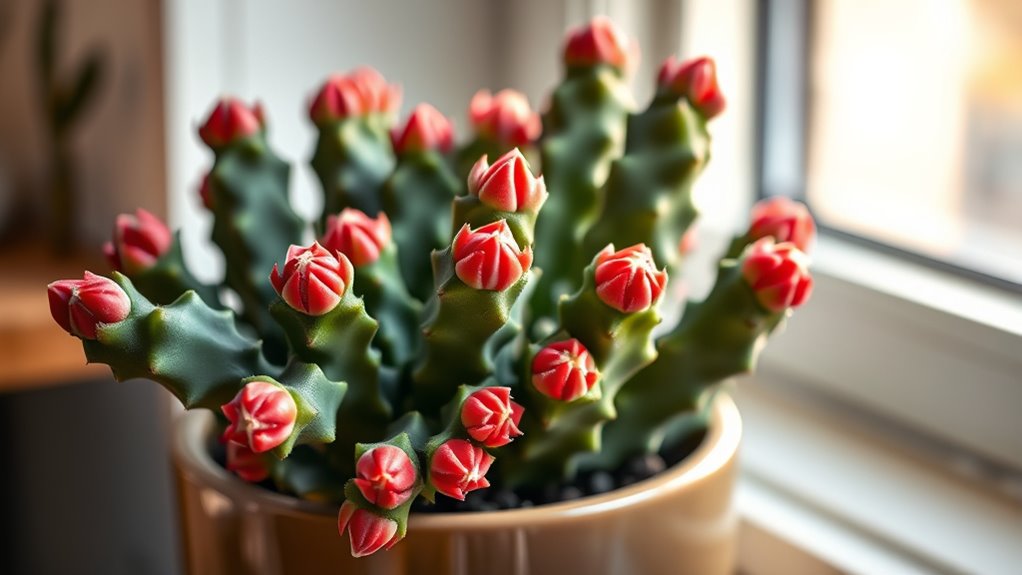
Controlling light exposure is key to encouraging your Christmas cactus to form buds. You’ll want to make certain it gets 12 to 14 hours of uninterrupted darkness each night during the critical weeks. Managing these dark periods carefully helps the plant recognize when to start blooming. Additionally, using a self watering plant pot can ensure consistent moisture levels, which supports healthy bud development and overall plant health. Ensuring proper light management is essential for optimal flowering and long-term vitality.
Control Light Exposure
To encourage your Christmas cactus to form buds, providing a consistent dark period of 12-14 hours each night for 6-8 weeks during fall is essential. This dark cycle signals the plant to initiate bud formation. During this time, avoid any light exposure that could disrupt this process. Cover the plant with blackout cloth or place it in a dark room to guarantee the dark period remains uninterrupted. Bright, indirect light during the day supports healthy growth but must not interfere with the dark cycle. Use the table below to help manage light exposure effectively:
| Light Condition | Action |
|---|---|
| During dark cycle | Keep in darkness |
| During day-time | Bright, indirect light |
| Artificial lights | Avoid or cover |
| Light pollution | Minimize or eliminate |
Consistent attention to these light conditions can significantly improve your cactus’s blooming success, as focused care cultivates optimal flowering conditions. Proper light management aligns with industry trends in plant care, which emphasize the importance of integrating multiple factors for optimal results.
Manage Darkness Periods
Managing the darkness periods during fall is key to successfully inducing your Christmas cactus to form buds. To do this, provide 12 to 14 hours of complete darkness each night for 6 to 8 weeks, starting in late September.
Use blackout cloth or place the plant in a dark room, ensuring no light leaks disrupt the cycle. Consistent, uninterrupted dark periods are crucial; even brief light exposure can prevent bud formation.
During this time, keep the environment between 60°F and 68°F to support proper development.
Once you see buds forming, gradually reintroduce light and increase daylight exposure. Proper light management during the dark period is essential for triggering and maintaining healthy bud formation on your Christmas cactus.
Managing Temperature and Darkness for Reblooming
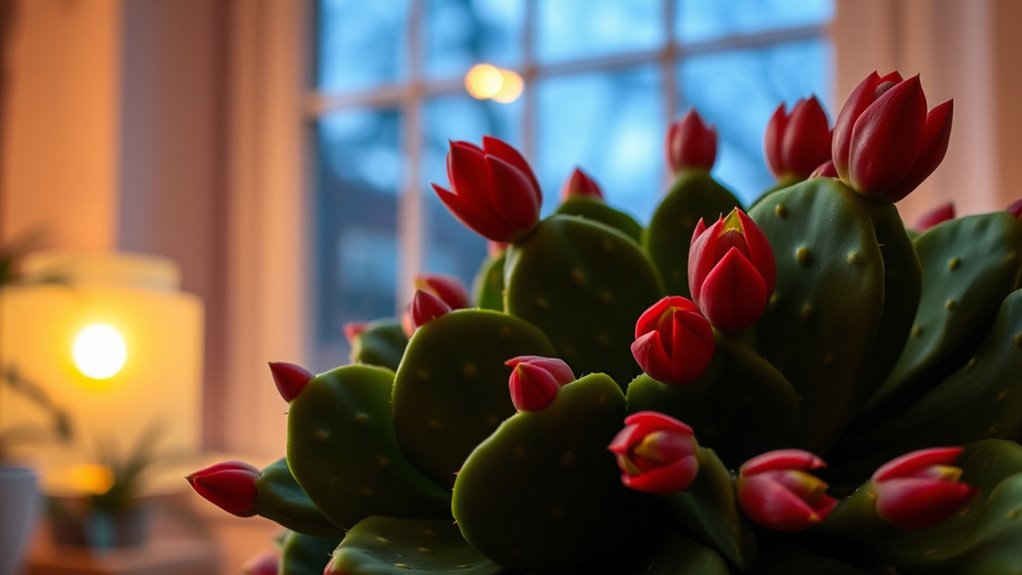
Reducing indoor temperatures to between 60°F and 68°F during the fall is essential for encouraging your Christmas cactus to rebloom. Cooler temperatures signal to the plant that it’s time to prepare for flowering, helping trigger the reblooming process.
Lower indoor temperatures to 60–68°F in fall to naturally trigger your Christmas cactus to rebloom.
Alongside temperature control, providing a consistent 12-14 hours of complete darkness each night is critical. Darkness during this period prevents light from interrupting the plant’s natural signaling process, which is indispensable for bud formation. Additionally, maintaining a consistent light schedule supports reliable blooming cycles. Using timers or automatic controls can help ensure that your plant receives the proper light-dark cycle without interruption.
Use blackout curtains or a dark room to ensure uninterrupted dark periods for 6-8 weeks. When both temperatures are kept cool and darkness is maintained, your Christmas cactus receives the right signals to initiate reblooming. Maintaining proper light-dark cycles is crucial for successful flowering.
Implementing proper automation techniques can help maintain these conditions consistently, ensuring your plant’s successful reblooming. This combination effectively mimics natural conditions, encouraging vibrant, healthy blooms.
Proper Watering and Humidity Strategies

Ensuring proper watering and humidity is essential for your Christmas cactus’s health and vibrant blooms. Water your plant only when the top inch of soil feels dry, usually every 2-3 weeks during growth.
In early fall, reduce water to create mild water stress, encouraging bud formation. HEPA filtration can help maintain clean air around your plant, preventing potential issues caused by airborne pollutants.
To boost humidity without overwatering, mist the plant regularly and place it on a tray of damp gravel. Maintaining appropriate humidity levels is crucial for supporting blooming and preventing shriveling stems.
Avoid overwatering, as excess moisture can cause root rot and make buds drop prematurely.
Maintaining consistent moisture levels and higher humidity during bud development promotes healthy flowering and prevents shriveling stems.
Regularly inspecting air quality around your plant helps prevent issues caused by pollutants that may affect its growth.
Keep these strategies in mind to support your cactus’s blooming potential:
- Water only when soil is dry
- Reduce watering in fall
- Mist frequently
- Use damp gravel for humidity
- Avoid overwatering at all costs
The Role of Fertilization in Promoting Flowers
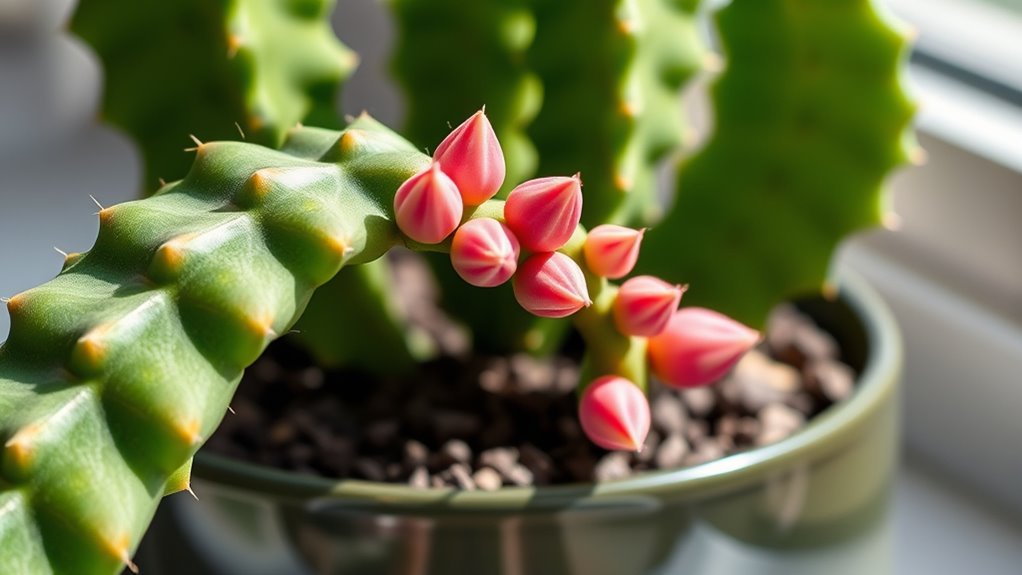
Fertilizing your Christmas cactus with the right type and timing is key to encouraging blooms. Use a balanced 10-10-10 formula during active growth.
Then switch to a bloom-boosting fertilizer with higher phosphorus when buds form. Adjust your feeding schedule to support healthy growth and vibrant flowers.
Proper Fertilizer Types
Choosing the right fertilizer is essential for encouraging your Christmas Cactus to produce vibrant blooms. During the active growing season, use a balanced fertilizer with equal parts nitrogen, phosphorus, and potassium (like 10-10-10) to support healthy foliage and stem growth.
When buds start forming, switch to a bloom-enhancing fertilizer with higher phosphorus (such as 0-15-10) to promote abundant flowering.
Once buds develop, reduce or stop fertilizing to prevent excessive foliage growth that can hinder blooms.
Applying liquid fertilizer every two weeks during spring and summer ensures consistent nutrients for ideal bud formation.
Be careful not to over-fertilize, as too many nutrients can weaken stems, impair bud development, and reduce flowering quality.
Understanding the importance of sound design techniques can also help you create a more engaging gardening experience, especially if you share your plant care journey through multimedia.
Proper fertilizer choice is key to a beautiful, flowering Christmas Cactus.
Timing of Application
Timing is essential when fertilizing your Christmas cactus to promote ideal flowering. Proper timing guarantees the plant directs energy toward flower buds instead of excessive foliage growth. During spring to early fall, fertilize every two weeks with a balanced 10-10-10 fertilizer to support healthy growth. Cease fertilization about a month before the expected blooming period, usually late October, to encourage blooming. During bud development, switch to a bloom-boosting fertilizer like 0-15-10 or skip feeding to enhance flowering. Here’s a quick overview:
| Stage | Fertilizer Type | Timing |
|---|---|---|
| Active Growth | 10-10-10 every two weeks | Spring to early fall |
| Pre-bloom | Cease fertilization | About one month before bloom |
| Bud Development | Higher phosphorus | During bud formation |
Using timing in fertilization is crucial for success, as it helps the plant allocate resources effectively and achieve vibrant blooms. Additionally, understanding the importance of plant nutrient management can significantly improve your results. Proper nutrient balance and soil health contribute to optimal flowering conditions.
Adjusting Nutrients for Bloom
Adjusting the nutrients you provide to your Christmas cactus during its bud formation phase can considerably influence its flowering success. Proper fertilizer timing is key—start with balanced fertilization in spring, then reduce or skip nitrogen-rich fertilizers like 10-10-10 once buds develop.
Switch to bloom-enhancing fertilizers with higher phosphorus (e.g., 0-15-10) to support flower development. Cease fertilizing entirely 4-6 weeks before blooming to let the plant focus on flowering rather than vegetative growth.
Over-fertilization, especially with nitrogen, encourages lush foliage but hampers blooms. To optimize flowering:
- Use high-phosphorus fertilizers during bud formation
- Avoid nitrogen-heavy feeds late in the season
- Stop fertilizing before bloom time
- Focus on phosphorus to promote flowers
- Maintain proper fertilizer timing for best results
Proper fertilizer timing can prevent over-fertilization and promote healthy blooms.
Pruning Techniques to Encourage Branching and Flowering

Pruning your Christmas cactus properly can considerably boost its branching and flowering potential. To encourage healthy growth, prune after flowering by twisting or clipping at stem segment connections, ideally in January or February. Water features in nearby parks can provide a relaxing environment to enjoy your plant’s beauty and growth progress. Removing leggy or damaged stems at their joints stimulates new branching and prevents the plant from becoming sparse or leggy. During the growing season, pinch off stem tips to promote lateral growth and more blooms later. When pruning, cut back to the main stem or a healthy side branch to trigger the development of multiple new growth points. Proper plant care is essential for maintaining the health and vibrant flowering of your Christmas cactus. Avoid heavy pruning during flowering, as it can reduce flower production. Instead, focus on regular light pruning after blooming to maintain a bushy, thriving plant capable of abundant flowering. Regular watering routines are also vital to prevent stress and encourage optimal blooming conditions.
Timing Your Care Routine for Year-Round Blooming
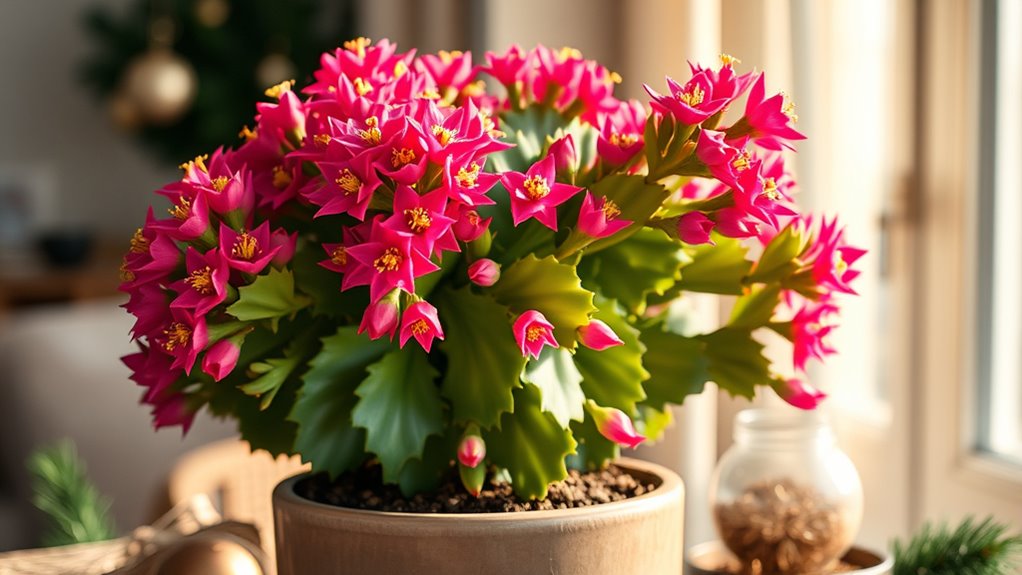
To achieve year-round blooming, you need to carefully coordinate your care routine with the cactus’s natural growth cycle. Start with a 6-week dark treatment each night in late September to simulate winter nights and trigger bud formation. During this period, guarantee the cactus receives no light, reinforcing the light cues needed for blooming.
Maintain consistent temperatures between 60°F and 68°F to support healthy bud development. Reduce watering and nitrogen-rich fertilizers gradually in early fall, encouraging the plant to focus energy on flowering.
After buds form, move your cactus to bright, indirect light and keep temperatures cooler to prolong blooming. Regularly monitor light cues and adjust your routine to keep the plant in ideal conditions for continuous flowering.
Troubleshooting Common Blooming Challenges

Troubleshooting blooming challenges often involves identifying environmental and care factors that disrupt the cactus’s flowering process. Temperature fluctuations greater than 10°F or drafts during bud formation can cause premature bud drop or prevent blooming altogether. Make certain your Christmas cactus stays in a stable environment, avoiding sudden temperature swings.
Overwatering or poor drainage can lead to root rot, hindering bud development and causing existing buds to fall off. Additionally, inconsistent or insufficient darkness during the critical 6-week dark period can prevent proper flowering.
High autumn temperatures above 68°F delay or stop blooms from forming. Ultimately, stress from changes in watering, light, or temperature often triggers bud drop.
Maintaining consistent care and stable conditions is key to overcoming these blooming challenges and encouraging vibrant flowers.
Post-Bloom Care to Ensure Future Flowers

After your Christmas cactus finishes blooming, proper care sets the stage for vibrant flowers next season. To support this, prune the plant by removing spent flower stems and leggy growth in January or February. This encourages bushier, healthier growth and prepares it for bud formation.
Reduce watering and stop fertilizing about 6-8 weeks after blooming, allowing the plant to enter a rest period. During this time, keep temperatures around 60-65°F to promote proper rest and future flowering.
Additionally, provide a consistent 12-14 hour dark period each night starting in early autumn to trigger bloom development. Maintain bright, indirect light during the day and avoid overwatering to prevent root rot.
These steps help ensure your Christmas cactus blooms beautifully year after year.
Frequently Asked Questions
What Can I Do to Make My Christmas Cactus Bloom?
To make your Christmas cactus bloom, you need to give it about 12-14 hours of complete darkness each night for 6-8 weeks, starting in late September.
Keep nighttime temperatures between 60°F and 68°F, and reduce watering during early fall.
Guarantee no artificial light interrupts its dark period, using blackout curtains if needed.
Skip fertilizing during bud formation, and be patient—full blooms typically appear after about 8 weeks.
How Do I Stimulate My Cactus to Flower?
Think of your cactus as a sleeping beauty waiting for its prince to wake it up. To stimulate flowering, you need to give it a dark, cool retreat for 12-14 hours nightly for about six weeks, starting in early fall.
Cut back watering during this time and feed with a high-phosphorus fertilizer once buds appear.
Keep it in bright, indirect light during the day, and no artificial lights at night.
Do Coffee Grounds Help Christmas Cactus Bloom?
Using coffee grounds can help your Christmas cactus bloom, but only if you use them sparingly. They provide nitrogen, which promotes healthy foliage, but too much can delay flowering. Slightly acidified soil from coffee grounds may benefit your cactus.
Remember, focus on proper light, temperature, and dark periods too—these are essential for blooming.
Use coffee grounds in moderation to avoid excess moisture and fungal issues that could harm your plant’s flowering.
Why Isn’t My Christmas Cactus Flowering?
So, your Christmas cactus isn’t flowering? Ironically, it might be because you’re spoiling it with too much light or warmth, preventing it from triggering blooms.
You need to give it about six weeks of complete darkness at night and keep temperatures between 60-68°F.
Be consistent with watering and make sure it gets enough natural light during the day.
Without these steps, your cactus might just keep waiting for a holiday that never arrives.
Conclusion
With the right care, your Christmas cactus can bloom like a burst of holiday magic year after year. By understanding its needs and tuning into its natural rhythms, you’ll nurture a plant that’s as dependable as a holiday tradition. Think of it as tending a delicate symphony—each element working in harmony to bring forth vibrant blossoms. With patience and attention, your cactus will continue to shine, turning your home into a festive garden of hope and beauty.
